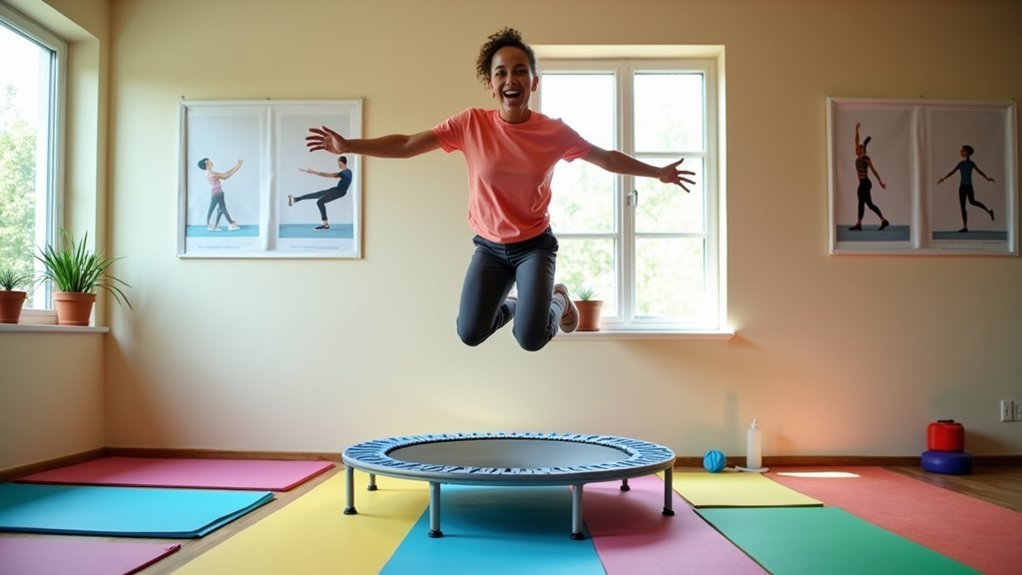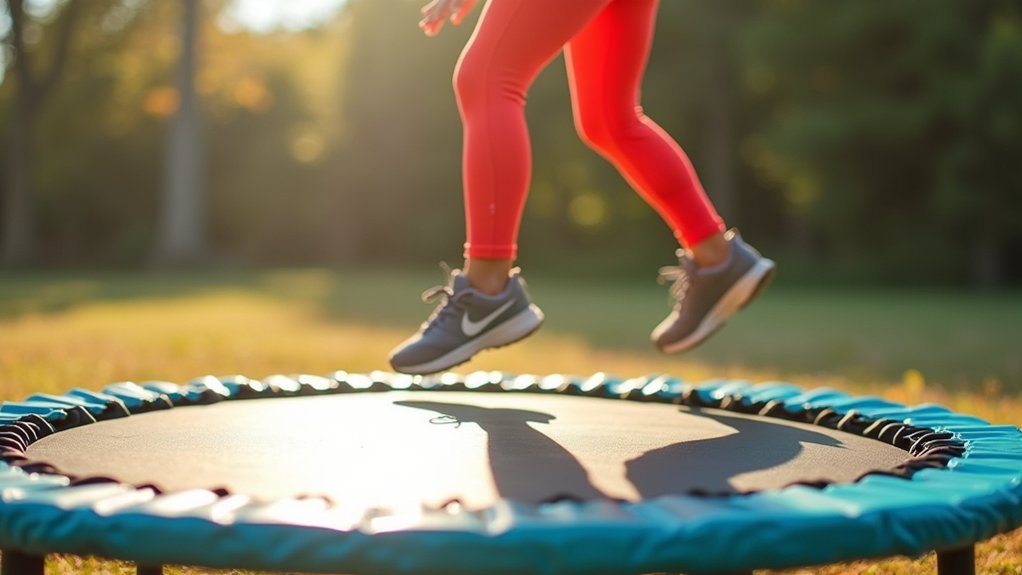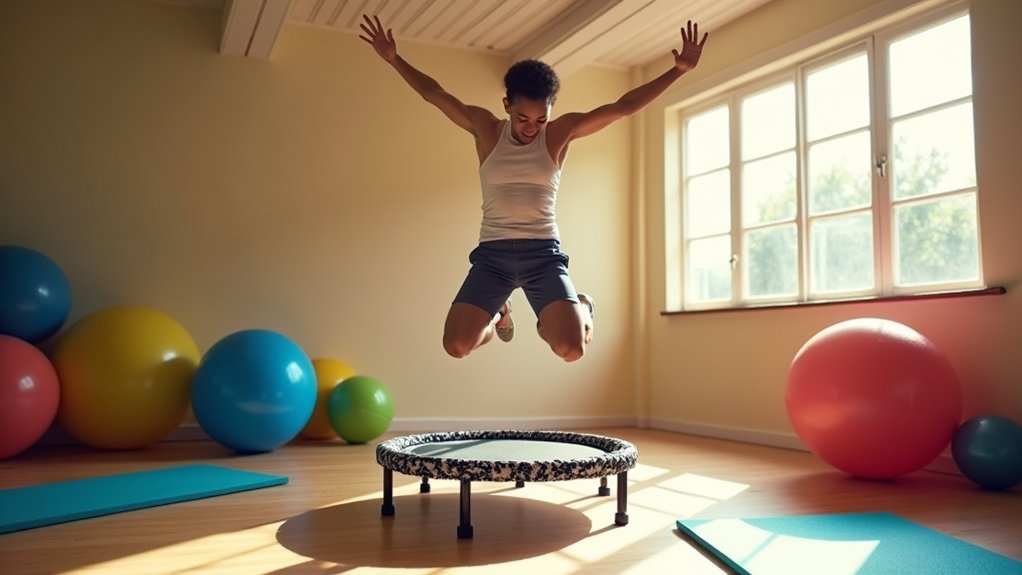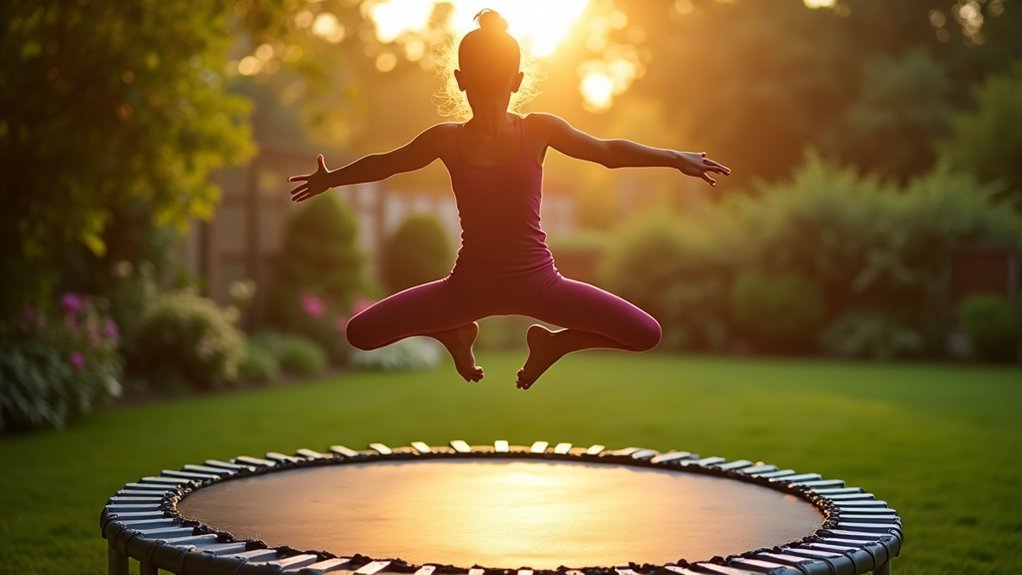Mini trampolines improve balance through several effective exercises: basic bounces with engaged core, marching in place, side-to-side movements, and single-leg stands. Start with a wide stance and proper alignment before progressing to more challenging movements like heel-to-toe walking and 360-degree turns. The trampoline’s unstable surface naturally activates your stabilizing muscles while reducing joint impact by 80%. Practice 2-3 times weekly for six weeks to experience significant stability improvements in your everyday activities.
Why Mini Trampolines Enhance Stability Training

When you step onto a mini trampoline, your body immediately engages in a complex balancing act. This unstable surface forces multiple muscle groups to work simultaneously, particularly strengthening your core—the foundation of balance and stability.
Unlike high-impact exercises, mini trampolines offer effective training while reducing stress on your joints. Each bounce creates moments of weightlessness followed by gentle resistance, challenging your body to maintain equilibrium throughout these changes. The trampoline mat absorbs over 80% of the impact, making it safer for those with joint concerns.
Mini trampolines deliver powerful results with gentle impact, creating a rhythm of floating and grounding that trains stability with every bounce.
Regular trampoline workouts improve your cardiovascular fitness and increase bone density, both contributing to better overall stability.
The constant micro-adjustments your body makes during bouncing train your proprioceptive system—your body’s awareness of its position in space—making you more stable both on and off the trampoline.
Basic Bouncing Techniques for Better Balance
To establish a foundation for balance training, start with a comfortable wide stance and engage your core while keeping your bounces low and controlled.
Focus on maintaining proper spinal alignment with a slight forward hip hinge as you press downward into the trampoline surface rather than jumping upward.
You’ll improve stability by coordinating your breathing with each bounce and gradually experimenting with foot positions, from wide to narrow stances as your confidence builds. If you’re new to rebounding, it’s normal to experience initial unsteadiness as your body adapts to the unstable surface.
Balance Bouncing Fundamentals
Three key elements form the foundation of effective mini trampoline exercise: proper stance, controlled movement, and engaged core muscles.
Begin with your feet shoulder-width apart, knees slightly bent, and heels raised during bounces. This positioning maximizes stability while minimizing joint impact.
To maintain balance, keep your abdominal muscles tight and distribute weight evenly across both feet. Your torso should remain upright throughout each movement. This engages your entire body, particularly activating your glutes, hamstrings, and core muscles for better stability.
Start with the “health bounce” – a gentle, small movement where you’re barely lifting off the surface.
As you gain confidence, vary your bouncing depth and speed. Shallow bounces offer greater control for beginners, while deeper bounces challenge your stabilizing muscles more intensely.
Remember to use stability bars if needed, especially when first starting out.
Core-Focused Rebound Exercises
Building on your foundational bouncing skills, core-focused exercises on the mini trampoline will dramatically enhance your balance capabilities. Your core muscles continuously engage during trampoline workouts, as the unstable surface demands constant stabilization. Incorporating exercises like the 100 or hip lifts provides an excellent opportunity to maintain 40 seconds of effort followed by quick transitions between movements.
| Exercise | Core Benefit | Difficulty |
|---|---|---|
| Twist Jumps | Rotational strength | Beginner |
| Plank Holds | Deep stability | Intermediate |
| Jump Squats | Power & control | Beginner |
| Side-to-Side | Lateral stability | Beginner |
| Dynamic Step-Ups | Multi-directional strength | Advanced |
Incorporate these exercises into your routine by alternating between different heights and movements. The unpredictable nature of the trampoline surface forces your core to adapt quickly, improving your reflexes and balance. For maximum effectiveness, mix high-impact jumps with controlled movements like planks to challenge your core from all angles.
Core-Focused Rebounding Movements

Your core serves as your body’s stability center, making it essential to target these muscles during mini-trampoline workouts.
Try plank-bounce hybrids where your hands remain on the floor while your feet rest on the rebounder, creating an unstable surface that demands constant abdominal engagement.
You’ll also benefit from seated abdominal pulses performed on the trampoline’s edge, which activate your deep core muscles through controlled pelvis lifts with arm support.
Incorporating knee lifts while maintaining your balance on the trampoline challenges your stabilizing muscles and improves overall coordination.
Abdominal Rebounding Workouts
Targeting your abdominal muscles through rebounding creates a uniquely effective core workout that combines stability challenges with dynamic movement patterns.
Begin with basic bounces while engaging your core—draw your navel toward your spine with each movement.
Progress to knees-to-chest tucks mid-bounce, requiring explosive abdominal contractions.
Try slow roll-ups from a seated position against the trampoline’s resistance for concentric and eccentric control.
For rotational stability, incorporate torso rotation drills while maintaining bounce rhythm.
Advanced exercisers can add ankle weights (2-3 lbs) to increase resistance or perform pulsed v-sit bounces that combine isometric holds with micro-rebounds.
Remember to synchronize your breathing—exhale during exertion—and maintain visual focus to reinforce neural core engagement throughout each exercise.
Incorporate the Pilates 100 position with arms forward while keeping your feet on the trampoline, which provides excellent neutral spine support while preventing back strain during abdominal exercises.
Plank Variations Aloft
Plank exercises take on new dimensions when performed on a mini trampoline, challenging your balance while intensifying core engagement. The unstable surface creates dynamic resistance that activates more muscle fibers than traditional floor planks, while reducing joint impact.
Begin with a basic plank position to establish balance, then progress to more advanced variations as your stability improves:
- Try knee tucks while maintaining plank position to engage your lower abdominals.
- Perform alternating leg lifts to challenge your stabilizing muscles and balance.
- Incorporate mountain climbers for a cardio-core combination that elevates heart rate.
- Shift between side planks to target obliques and improve rotational stability.
The forearm position on the trampoline creates an incline from floor that increases difficulty while developing stronger core stabilization. Always focus on proper alignment and form, using interval training to progressively increase your time in each position.
Single-Leg Exercises to Challenge Equilibrium
While traditional exercises build strength, single-leg movements on a mini trampoline create an entirely new dimension of balance training. When you stand on one leg atop the unstable surface, your body must constantly adjust to maintain stability, engaging your core, glutes, and hamstrings simultaneously.
Try starting with single-leg squats by shifting your weight to one foot, lifting the opposite leg, and lowering yourself while keeping your heel planted firmly. For knee drives, balance on one leg while bringing the opposite knee toward your chest in controlled movements. A complete single-leg rebounding workout should alternate sides to ensure balanced muscle development.
Choose a rebounder with arched legs and elastic bungees for peak stability. For added challenge, incorporate medicine balls or alternate between single and double-leg exercises to improve your shift skills and overall equilibrium.
Proprioception Development Through Rebounding

As your body experiences the unique sensation of rebounding on a mini trampoline, your proprioceptive system receives constant feedback about position and movement. This continuous input enhances your body’s awareness in space, improving balance and coordination while reducing neuromuscular fatigue compared to hard-surface exercises.
The rebounding motion challenges your center-of-mass management skills, forcing your muscles to make micro-adjustments that strengthen stabilizing muscles and improve posture. Your leg muscles develop spring-like dynamics that enhance elastic energy use during everyday movements. The vestibular receptors in your inner ear are simultaneously stimulated through the repeated acceleration and deceleration of bouncing movements.
- Varying jump heights progressively challenges motor control
- Dynamic movement patterns trigger constant postural adjustments
- Proprioceptive challenges during airborne phases improve spatial awareness
- Regular practice enhances executive functions and cognitive abilities
These benefits make mini trampolines effective tools for both rehabilitation and everyday balance training.
Dynamic Balance Drills for All Fitness Levels
Mini trampolines offer an ideal platform for practicing dynamic balance exercises that benefit individuals across all fitness levels.
You’ll find basic bouncing and marching in place perfect for beginners, while side-to-side steps and heel raises challenge your lateral stability and strengthen calf muscles.
As your fitness improves, try advanced exercises like one-legged stands with arms extended. These workouts effectively burn calories while being gentle on your joints.
Research shows they’re as effective as resistance training for improving dynamic balance in young adults, with notable improvements occurring after just six weeks of twice-weekly sessions.
Whether you’re a senior using support handles, a stroke patient rebuilding postural control, or an advanced exerciser seeking challenge, trampoline drills can be customized to your specific needs and abilities. Rebounding has shown a remarkable 35% improvement in balance for seniors who incorporate these exercises into their routine.
Progressions From Beginner to Advanced Balance Work
You’ll find success with mini trampoline balance work by focusing on gradual progressions that build upon foundational skills.
Start with basic bouncing and assisted steps before challenging yourself with intermediate weight transfers and eventually advancing to single-leg work and dynamic turns. Incorporating movements like gentle rocking side to side with a wide stance can help beginners develop initial stability while engaging the core.
These small, incremental improvements in your balance practice will compound over time, delivering significant stability benefits that extend beyond your trampoline sessions.
Balance Progression Pathway
When starting your mini trampoline balance journey, following a structured progression pathway guarantees both safety and skill development.
Begin with weight shifts and static holds before advancing to simple marching and low-amplitude jumps.
As your confidence builds, incorporate these intermediate challenges:
- Heel-to-toe walking combined with side stepping exercises
- Single-leg stands progressing to front knee raises and side leg lifts
- Tandem walking along imaginary lines on the trampoline surface
- Jump and step combinations that develop dynamic balance control
Once you’ve mastered these elements, advance to high-amplitude jumps, 360-degree turns, and eventually performing exercises with your eyes closed.
Throughout each progression, listen to your body’s signals and modify exercises based on your comfort level. Seniors especially benefit from rebounding as it minimizes joint stress while providing effective balance training.
Small Steps, Big Results
Building on the balance progression pathway, let’s examine how specific incremental steps transform your mini trampoline practice from novice movements to advanced techniques.
Begin with basic bouncing and simple walking movements while holding a stability bar. As you gain confidence, incorporate rhythmic steps and side-to-side movements, always engaging your core and maintaining proper posture. The mini trampoline provides soft landing support that makes these exercises particularly joint-friendly compared to traditional balance training.
Next, add arm movements and knee raises to challenge your coordination. Progress by removing the handlebar support and practicing weight transfers during bounces.
For advanced work, try closing your eyes during simple bounces to enhance proprioception. Graduate to single-leg stances and complex movement patterns that combine multi-directional movements.
Eventually, incorporate functional training elements that mimic daily activities, increasing both duration and intensity as your balance improves.
Combining Arm Movements to Intensify Balance Challenges
Mastering balance on a mini trampoline requires more than just bouncing up and down. When you add purposeful arm movements to your routine, you’ll greatly increase the stability challenge while enhancing coordination and core strength.
- Extend your arms while bouncing to create greater stability and improve your overall balance.
- Incorporate multi-directional punches to enhance reaction times and body coordination.
- Perform twisting bounces with complementary arm movements to engage your core stability.
- Try dynamic changes between arm positions (like guard stance to extended reach) to force quick balance adaptations.
For an extra challenge, add light weights to your arm movements or combine arm extensions with knee bends. Maintaining strong muscle tension throughout your movements will maximize the effectiveness of your balance training.
These compound movements not only test your equilibrium but also activate multiple muscle groups simultaneously, maximizing your mini trampoline workout.
Timed Stability Holds on Unstable Surfaces
Timed stability holds transform your mini trampoline workout from a cardiovascular exercise into a serious balance-training powerhouse. These holds activate your deep stabilizer muscles more effectively than stable-surface exercises, creating greater neuromuscular coordination as your body fights to maintain equilibrium. Studies show that training on unstable surfaces can maintain muscle activation even at reduced loads compared to stable surface training.
| Duration Level | Eyes Open | Eyes Closed |
|---|---|---|
| Beginner | 10-30 sec | 5-15 sec |
| Intermediate | 30-60 sec | 15-30 sec |
| Advanced | 60+ sec | 30+ sec |
For ideal results, practice holds 2-3 times weekly, progressing from double-leg to single-leg stances. You’ll notice improvements in core activation, ankle stability, and proprioception—especially when you close your eyes to increase the challenge. These benefits transfer directly to real-world scenarios requiring balance on unstable surfaces like icy sidewalks or uneven trails.
Rebounding for Seniors: Safe Balance Enhancement
As we age, maintaining balance becomes increasingly essential for preventing falls and preserving independence. Mini trampolines offer seniors a safe, effective way to enhance stability while providing low-impact exercise that’s gentle on aging joints.
Balance is the cornerstone of healthy aging, with mini trampolines providing gentle yet effective stability training for senior independence.
When introducing rebounding to your fitness routine, prioritize these senior-specific techniques:
- Start with basic bounces while holding onto a support rail, gradually shifting to hands-free balance walks.
- Practice toe-touch balances by tapping different points on the trampoline frame to improve coordination.
- Try single-leg stands for 10-30 seconds to strengthen stabilizing muscles.
- Incorporate heel-to-toe walking across the trampoline surface to challenge your equilibrium.
Always consult your healthcare provider before starting, and consider working with a partner or supervisor during initial sessions to guarantee safety. Position your feet hip-width apart with a micro bend in knees for optimal stability during all exercises.
Athletic Performance Benefits of Trampoline Balance Training
While professional athletes have long incorporated mini trampolines into their training regimens, these versatile devices offer significant performance benefits for competitors at all levels. You’ll experience improved proprioception and reaction time, giving you a competitive edge in dynamic sports like basketball and martial arts. Regular trampoline workouts can significantly improve your overall core strength as you maintain balance during each jump.
| Sport Type | Key Benefit | Training Focus |
|---|---|---|
| Martial Arts | Enhanced reaction time | Quick direction changes |
| Basketball | Improved vertical leap | Explosive movements |
| Snowboarding | Better aerial awareness | Rotation control |
Trampoline training enhances your cardiovascular fitness while minimizing joint stress, making it ideal for both intensive training periods and injury recovery. Your core muscles constantly engage during rebounding exercises, developing the functional strength needed for efficient movement patterns across virtually all athletic disciplines.
Measuring Your Balance Improvements Over Time
Tracking your balance improvements systematically helps you determine whether your mini trampoline exercises are truly effective.
Standardized assessments like the Berg Balance Scale or One-Legged Stance Test provide objective benchmarks of your progress over time.
Establish a consistent monitoring routine to accurately measure your gains:
- Conduct a baseline test before starting your program, then reassess weekly using simple metrics like how long you can maintain single-leg balance.
- Progress from eyes-open to eyes-closed challenges once you’ve mastered basic stability.
- Use your smartphone to time balance holds or record sessions for posture analysis.
- Create a digital log tracking your performance across 6-week intervals, when most significant improvements typically occur.
Consider collecting both quantitative and qualitative data for a comprehensive assessment of your balance improvements.
Wearable technology can provide additional insights into your balance metrics through pressure sensors and movement analysis.
Frequently Asked Questions
Can Rebounding Exercises Help With Inner Ear Balance Disorders?
Yes, rebounding exercises can help your inner ear balance disorders by stimulating vestibular adaptation, improving visual-vestibular integration, and promoting habituation to motion. You’ll experience reduced dizziness and better stability with consistent practice.
How Do Weather Conditions Affect Outdoor Mini Trampoline Balance Training?
Weather considerably impacts your outdoor rebounding. Wind challenges stability, precipitation creates slippery surfaces, temperature affects muscle response, and poor air quality reduces stamina. You’ll need to adapt your training to these environmental factors.
Is Balance Training on Trampolines Safe During Pregnancy?
Always consult your healthcare provider before using trampolines during pregnancy. You’ll need to evaluate falling risks, changing center of gravity, and joint instability. Most experts recommend safer alternatives for balance training while pregnant.
Can Children With ADHD Benefit From Balance-Focused Rebounding Exercises?
Yes, your ADHD child can benefit from balance-focused rebounding exercises. They’ll improve neural coordination, enhance focus, and provide engaging physical activity. The structured nature of mini-trampoline exercises may help reduce ADHD symptoms.
How Do Barefoot Versus Shoes Affect Balance Training Outcomes?
Barefoot training enhances your proprioception and tactile sensitivity, improving sensory feedback. With shoes, you’ll gain stability and comfort but sacrifice some neurological engagement. Both approaches can improve balance, but they develop different adaptations.
In Summary
You’ve now got a variety of balance-boosting exercises for your mini trampoline! Whether you’re focusing on single-leg holds, core stability, or timed challenges, consistent practice will strengthen your proprioceptive system and improve overall equilibrium. Remember to start with basics and progress gradually. As you continue your rebounding journey, you’ll notice improved stability not just on the trampoline, but in your everyday movements and athletic performance too.





Leave a Reply